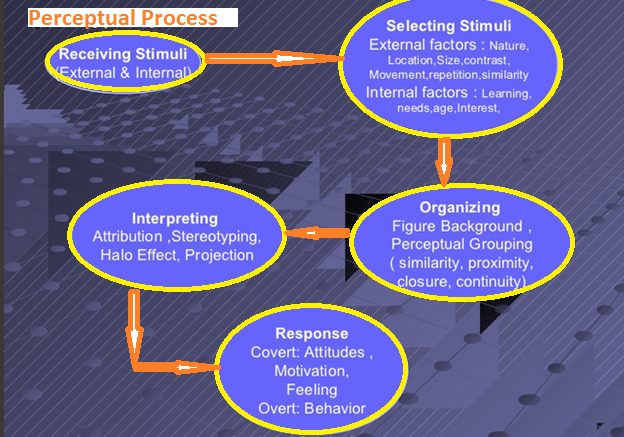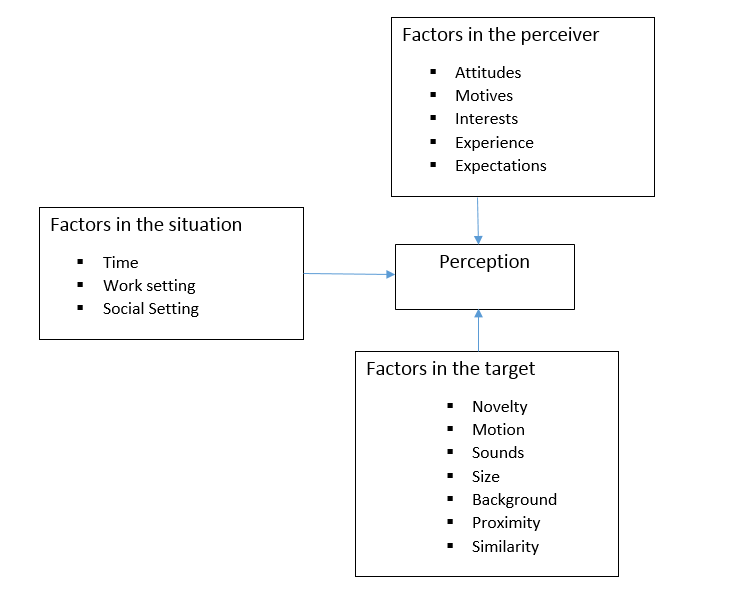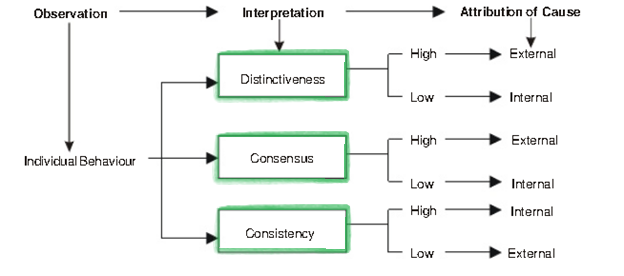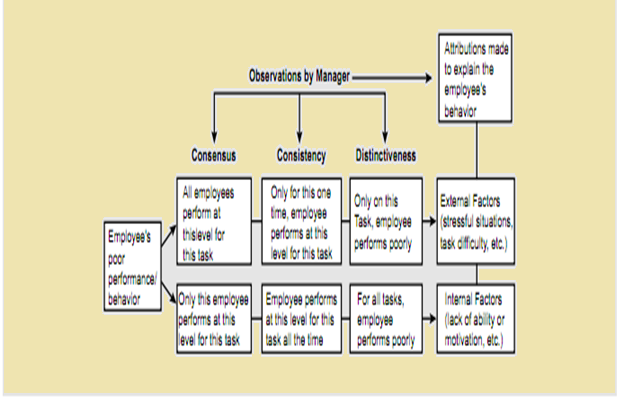The individual processes: Perception (Organisational Behaviour and Design)
In theoretical studies, perception is described as a cognitive process. People's individual differences and distinctiveness are mainly the result of the cognitive processes they use in processing the information they receive and conclusions they make. Perception is interpretation of the situation by a person and it is not an exact recording of it. Perception and organizational behaviour has strong link in smooth process of business operation. It is observed that perception of an employee regarding factors in an organization greatly affect the manner in which he or she reacts in the organization. This process of perceiving events is a complex process that is shaped by individual preconceived notions regarding certain factors.
In organizations, perceptions of leaders, managers and employees form the climate and efficiency of the working environment. Perception is the way people interpret their experiences. When managers have the right perception, they become capable for any effective leadership. It is important to recognize that perception is often showed through communication in any organization. Many psychologists stated that Perception is significant part of organizational behaviour. Robbins, Millet, Cacioppe and Marsh (2001) describe perception as the way individuals process their respective sensory impressions in order to identify their environment. In an organizational, Robbins and colleagues (2001) recognized selective perception, stereotyping, contrast effect, projection and the halo effect, as five frequently used shortcuts, used by managers, to evaluate employees and other groups associated with business.
Perceptual process: Perception is sensory experience of the world around people and involves both the recognition of environmental stimuli and actions in response to these stimuli. Through the perceptual process, people expand information about properties and elements of the environment that are significant to survival. Perception creates person’s experience of environment as well as it allows people to act within same environment. The perceptual process is the series of psychological steps that a person uses to organize and interpret information from the outside world. Majority of psychologists explain three stages of perception in organization setting. The first is sensory stimulation. Good or bad memories are invoked which may influence ones reaction in a given situation. The second stage in the perception process is the organization of that stimulus in brain i.e. developing a positive or negative cerebral response to the stimulus. This is a process in which people attempt to organize things in such a way that they make sense to them. The third stage of the perception process involves interpreting and expressing the thoughts that have been elicited, often involving an emotional response.
Perceptual Process:
Factor influence perception: A number of factors operate to shape and deform perception. These factors can exist in the perceiver, in the object or target being perceived, or in the context of the situation in which the perception is made.
The Perceiver: When an individual looks at a target and attempts to interpret what he or she sees, that interpretation is heavily influenced by personal characteristics of the individual perceiver. Among the more relevant personal characteristics affecting perception are attitudes, motives, interests, past experiences and expectations. People with certain attitude towards female colleagues or those speaking a particular language are likely to perceive various minor things about members of these groups which may otherwise go unnoticed. The unsatisfied needs or motives stimulate individuals and may exert a strong impact on their perceptions. This fact was considerably established in a research study on hunger as cited by Stephen P. Robbins in his manual on Organizational Behaviour.
The Target: Characteristics of the target that is being observed can affect what is perceived. Loud people are more likely to be noticed in a group than are quiet ones. So are the extremely attractive or unattractive individuals. Motion, sound, size and other attributes of a target shape the way people see it.
The Situation: The background in which people observe objects or events is important. Elements in the surrounding environment influence our perception. People may not notice an operator working on a machine in company uniform during general shift.
Factor influence Perception
Regardless of innumerable things that tend to influence the way people perceive things or situations the most relevant are those that are within one like habit, motivation, learning, specialization and social background.
Habit: Habits are formed slowly and sometimes unconsciously and as the saying goes ‘habits die hard’ and therefore individuals perceive objects, situations and conditions differently according to their habits.
Motivation: Motivational factors boost the individual's sensitivity to those stimuli which he considers as relevant to the satisfaction of his needs in view of his past experience with them.
It is recognized that the role of learning is more obvious in respect of complex forms of perception where the symbolic content that is recognizable creeps into the process. People perceive as per their levels of learning. It is essential for the organization to make its management well-informed and educated for their effective performance and behaviour.
Specialization: The modern organizations value specialization. Consequently the specialty of a person that casts him in a particular organizational role predisposes him to select certain stimuli and to disregard others. Thus in a lengthy report a departmental head will first notice the text relating to his department.
Social background: The worker perceptions are based on social backgrounds. Socially developed workforce has a more positive attitude towards development rather than less developed employees.
Theoretical perspective of perception: Attribution theory of perception propose that when people evaluate human behaviour, it is either internally caused or it is caused due to external factors as explained above.
Figure: Attribution Theory of Perception
Perception is strongly related to attitudes. Attribution theory was first developed by Heidler (1958) as “naive psychology” to explain the behaviours of others by describing ways in which people make casual explanations for their actions. Heidler thought that people have two behavioural motives: (1) the need to understand the world around them; and (2) the need to control their environment. Heidler proposed that people act on the basis of their beliefs whether or not these beliefs are valid. Weiner (1979) recommended that individuals justify their performance decisions by cognitively constructing their reality in terms of internal-external, controllable-uncontrollable, and stable-unstable factors. Weiner (1979) stated that when one tries to describe the processes of explaining events and the relating behaviour, external or internal attributions can be given. An external attribution assigns causality to an outside agent or force. An external attribution claims that some outside force motivated the event. By contrast, an internal attribution assigns causality to factors within the person. An internal attribution claims that the person was directly responsible for the event. Controllability refers to whether the person had the power to exert control over the events of the situation. Finally, stability of the cause relates to whether the behaviour is consistent over time because of the individual’s values and beliefs or because of outside elements such as rules or laws that would govern a person’s behaviour in the various situations. Fundamental attribution error occurs when the influence of external factors is underestimated and the influence of internal factors is overestimated in regard to making judgments about behaviour. Self-serving bias is the tendency for individuals to attribute their own successes to internal factors while putting the blame for failures on external factors. When workers make attributions about a negative event that happened at work, they tend to underemphasize internal (dispositional) factors such as ability, motivation, or personality traits and exaggerate (external) situational factors. Managers are often in a position where they make causal attributions regarding an employee’s behaviour or work pattern. Kelley’s (1973) model of attribution theory incorporates three attributions: consensus, consistency, and uniqueness.
Kelley’s Attribution Theory Mode
Aspect of personality that affects perceptions: Costello, Zalkind (1962) and Hamacheck (1971) designate relationship between personality factors and perception. Secure person perceives others as warm individuals. Thoughtful individuals do not perceive situation in terms of Black and White but understand that there can be different shades of grey. Hence they do not make judgments based on single piece of evidence. Self-accepting people perceive others liking and accepting them. Those who are not self-accepting tend to distrust others. Self-accepting person also accepts others easily which is not true of those who are not self-accepting. People tend to perceive others more accurately when they are more like the ones they perceive than if they are different from those who are being perceived.
Common Errors While Judging Others
Selective Perception: Individuals selectively construe whatever they observe based on their thoughts, interest, background and experience. In company, person might have been chosen for higher post in the visit of CEO and the appointment may be incidental but people usually perceive appointments as an effect of CEO’s visit. In an organization, numerous activities occur but different persons will distinguish one fact in a different way based on individual’s selectivity in observing which is normally based on his past experience and approach towards employment. People may make mistakes in perceiving others in work setting. For accurate perception an individual must be observed, studied, tried and later perceived without an individual prejudice.
Similarity error: People are inclined towards those having similar traits, socio-economic-cultural background.
Race/gender/age bias: People’s perception may be tempered by their prejudices vis-à-vis race, gender, and age.
First impression error: People may hold a long-term vision about a person or thing based on first impression.
Halo Effect: Halo effect is another error in perceiving people in work environment. It is explained as judging an individual based on single characteristics for example academic ability, sociability and appearance. It normally occurs during performance appraisal where the manager rates a worker on the basis of only one trait e.g. intelligence, punctuality, cooperativeness appearance.
Projection: It is the propensity of seeing one’s own traits in others. It is commonly found that subordinates do or exhibit the same behaviour as desired by the boss. Projection, an error that is widespread in any organization. Projection may be particularly strong for unwanted traits that the perceivers possess but fail to identify in themselves. People whose personality traits include stinginess, obstinacy, and disorderliness tend to rate others higher on these traits than do people who do not have these qualities.
Contrast error: People tend to compare among the available resources and thus reach at a conclusion that might be far from the objective reality.
Stereotyping: It is the conviction that all members of a particular groups share similar qualities and behaviour. Most often, a person is put into a stereotype because the perceiver knows only the overall category to which the person belongs. However, because each individual is unique, the real traits of the person are usually quite dissimilar from those that stereotype would suggest.
Self- Fulfilling Prophecy: It is also recognized as Pygmalion effect in which the person’s expectation of another (target) has an influence on or is transferred to the subject in such a way that the subject alters his or her behaviour in conformity to the expectations. Pygmalion effect models are developed by researchers (McnNatt, 2000), these models exemplify how manager’s behaviour results in self expectancy of subordinates, thus motivates employees which in turn leads to increased performance.
It is established that perceptual biases of raters affect the accuracy of interviewer’s judgement of applicants. People’s perceptions may often be very impractical. Many studies have revealed huge errors and biases in perceptions (Kiesler and Sproull, 1982). With reference to perceptions, studies have shown that what employees perceive from their work situation influences their efficiency. Therefore, to influence productivity, it is essential for managers to assess how workers perceive their jobs. Other factors like absenteeism, turnover and job satisfaction are important in an employee’s perception of the job. Those individuals who perceive their jobs as negative are likely to have increased absenteeism, more frequent turnover and less job satisfaction. The only way to influence these variables is to recognize how an employee personally perceives the workplace. It can be said that perception influences decision-making within an organization.
To summarize, perception in organizational setting is a process by which employees organize and interpret their sensory impressions in order to give meaning to their environment. It can be concluded that perception is the root of all organization behaviour. Any situation can be analysed in terms of perceptual connotation. Through perception, people process information inputs into responses involving feelings and action. Perception is a way of forming impression about oneself. There are many factors that influence on perceptual process such as attitude, motives, time work setting, social setting, novelty, motion, proximity, similarity and others. Attribution theory in perception denotes that when person observe behaviour, he tries to assess whether it is externally or internally caused.
